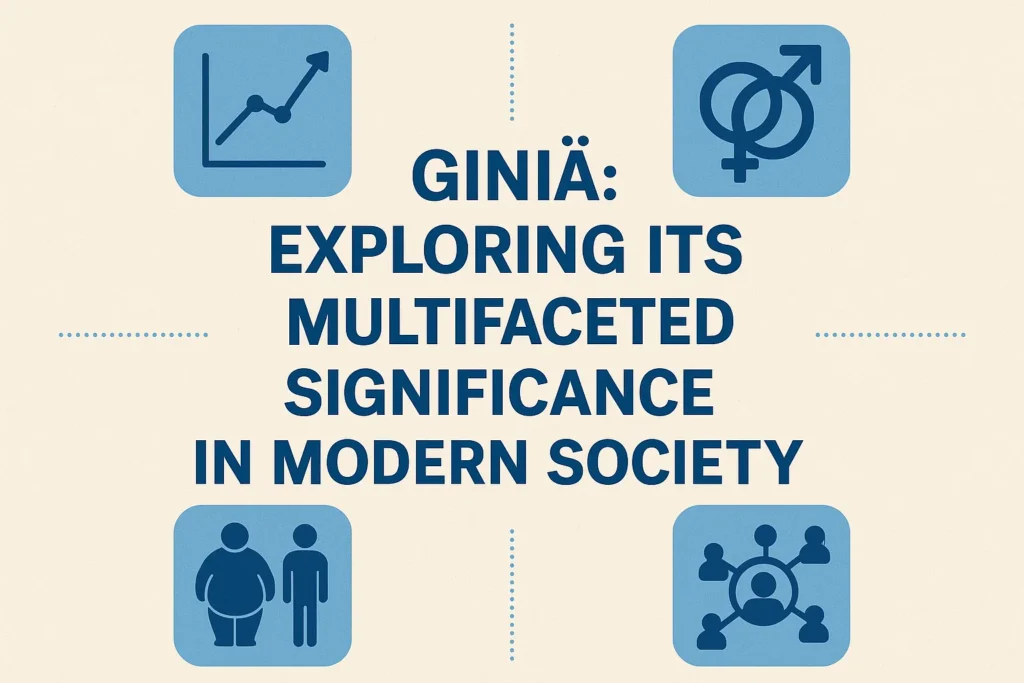The term Giniä is one that has diverse meanings and applications across various sectors, from economics to cultural contexts. It is a word that has evolved over time, embodying different ideologies and practices depending on its usage. In this article, we will delve into the various interpretations and applications of Giniä, explaining its relevance and impact in today’s world.
The Gini Coefficient: A Statistical Measure of Inequality
The most widely recognized connection to Giniä is its association with the Gini coefficient. The Gini coefficient is a statistical measure used in economics to gauge income or wealth inequality within a population. Named after Italian statistician Corrado Gini, this measure helps policymakers and economists understand the degree of inequality in income distribution.
On a scale from 0 to 1:
- A Gini coefficient of 0 represents perfect equality, where everyone earns the same income.
- A Gini coefficient of 1 represents perfect inequality, where one person earns all the income.
Governments and organizations use the Gini coefficient as a tool to evaluate the effectiveness of economic policies and to advocate for actions that promote equality. A higher Gini index indicates a greater disparity between the wealthy and the impoverished in a country. Therefore, understanding this coefficient is crucial in developing strategies to reduce poverty and create a more equitable society.
Giniä in Branding and Consumer Culture
Beyond its roots in economics, Giniä has found a place in branding and consumer culture. The term has become synonymous with modern aesthetics and values, particularly in industries focused on sustainability, innovation, and elegance. Companies are increasingly adopting Giniä to represent a commitment to environmentally-friendly practices, quality, and cutting-edge technology.
For example, a company that focuses on eco-friendly products may choose to name itself after Giniä or incorporate the term into its branding to symbolize its dedication to sustainability. Similarly, startups and brands in the wellness sector may use the name Giniä to convey a sense of purity, mindfulness, and holistic living. In this context, Giniä becomes a symbol of contemporary values, appealing to an audience that is socially and environmentally conscious.
Giniä in Wellness and Lifestyle
In the realm of wellness and personal growth, Giniä has evolved to symbolize balance, mindfulness, and personal development. The modern lifestyle movement, which focuses on conscious living, wellness, and holistic health, aligns well with the ideals that Giniä promotes. As people look for ways to integrate mental and physical health practices into their daily lives, Giniä offers a term that encapsulates these aspirations.
Whether it’s through meditation, fitness, or sustainable living, Giniä represents the harmony between mind, body, and the environment. For individuals who seek balance in their lives, Giniä resonates as a term that encourages making healthier, more sustainable choices for long-term well-being. It’s not just about physical health but also mental and emotional clarity—making it a perfect fit for wellness enthusiasts who prioritize holistic living.
Giniä’s Cultural Significance
Giniä is also tied to cultural significance, representing unity, tradition, and community across different societies. It serves as a bridge between heritage and modernity, fostering connections among individuals and groups who share common cultural practices and values. In this context, Giniä acts as a reminder of the importance of cultural preservation, while also encouraging the adoption of progressive and inclusive practices that respect diversity.
Cultural organizations, festivals, and community initiatives that focus on cultural heritage preservation might use Giniä to symbolize their commitment to keeping traditions alive in the face of globalization. As cultures evolve, Giniä becomes a unifying symbol of shared experiences and collective identities that transcend geographic and social boundaries.
Real-World Impact of Giniä
The diverse uses of Giniä in both practical and conceptual contexts show its versatility. In economic terms, it plays a role in assessing wealth inequality, while in branding, it serves as a symbol of modern, sustainable values. In wellness, it represents the pursuit of balance and holistic living, and culturally, it stands as a beacon of tradition and unity.
These applications highlight how Giniä has become an adaptable and meaningful concept in modern society. From its use in policy analysis to its significance in lifestyle and wellness movements, Giniä provides a framework for understanding not only economic and social disparities but also personal and cultural growth.
Conclusion
Giniä may have started as a statistical term, but it has since grown to represent much more. Whether it’s advocating for fairness in income distribution, serving as a symbol for sustainable living, or embodying cultural unity, Giniä is a concept that transcends its original definition. By understanding its broader significance, we can appreciate its potential to shape both personal and societal progress in an ever-changing world.
